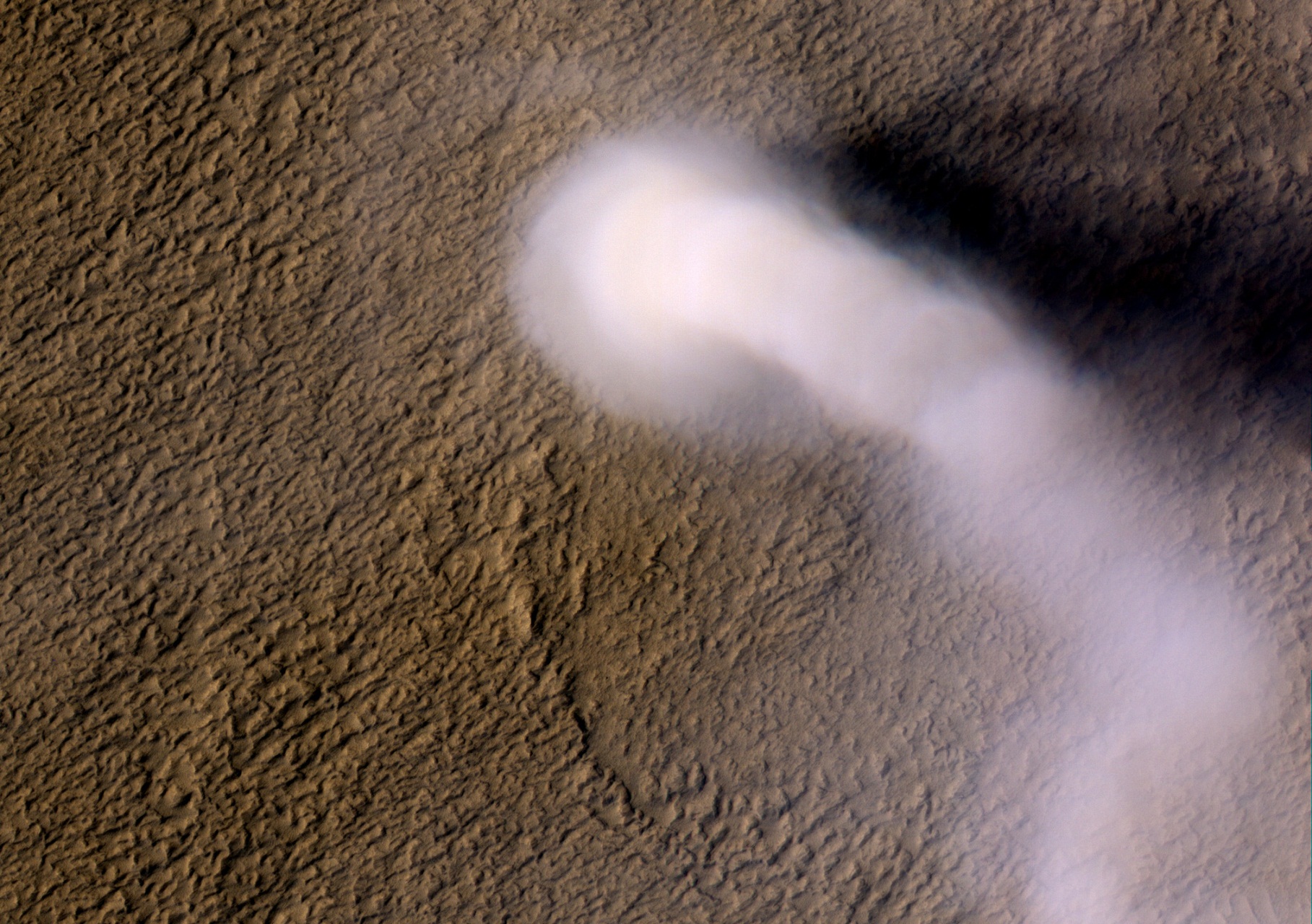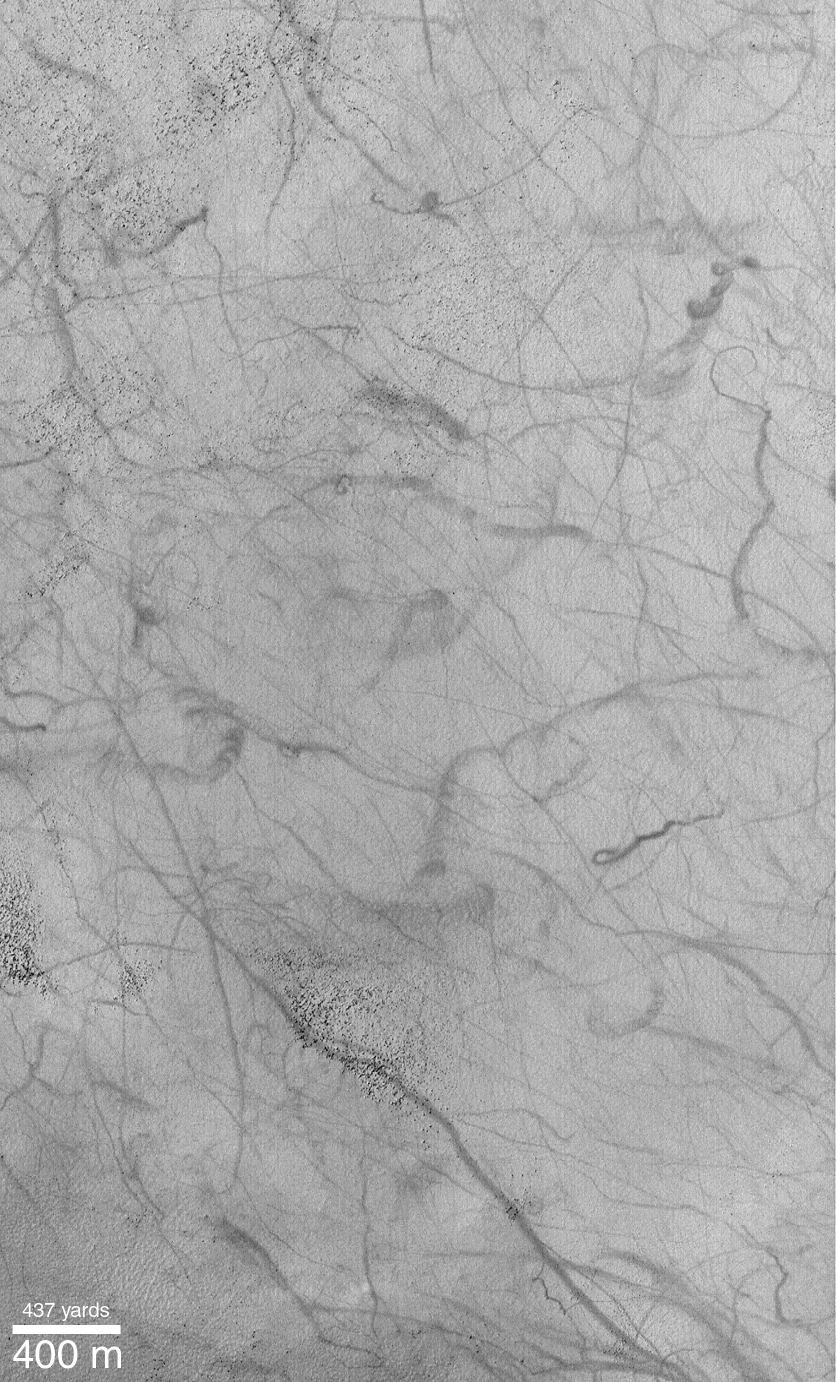The picture was taken on 30th December 1999 by Mars Global Surveyor (MGS) Mars Orbiter Camera (MOC), showing an area approximately 3 km by 5 km in Promethei Terra at a latitude of 58°S crisscrossed by dark streaks. Image credit: NASA/JPL/Malin Space Science Systems.
Let’s look at more devils:

The dust devil seen making a streak —located in Promethei Terra— was traveling from right (east) to left (west). A columnar shadow was cast by sunlight coming from the upper left. This shadow indicates the true shape of the dust devil. The bright dust devil itself does not look like a column because the picture was taken from a camera looking straight down on it. The dust devil is less than 100 meters (less than 100 yards) wide and the picture covers an area approximately 1.5 by 1.7 kilometers (about 1 by 1 mile). Image credit: NASA/JPL/Malin Space Science Systems.

Dust devil on Mars, photographed by the Mars rover Spirit. The series of images show dust devil original taking time 9 minutes and 35 seconds on Spirit’s sol 486. Image credit: NASA/JPL.

A Martian dust devil roughly 12 miles (20 kilometers) high was captured winding its way along the Amazonis Planitia region of Northern Mars on March 14, 2012 by the High Resolution Imaging Science Experiment (HiRISE) camera on NASA’s Mars Reconnaissance Orbiter. Despite its height, the plume is little more than three-quarters of a football field wide (70 yards, or 70 meters). Image credit: NASA/JPL-Caltech/UA. Full Image and caption.

This portion of a recent high-resolution picture from the HiRISE camera on board the Mars Reconnaissance Orbiter shows twisting dark trails criss-crossing light coloured terrain on the Martian surface. Newly formed trails like these had presented researchers with a tantalizing Martian mystery but are now known to be the work of miniature wind vortices known to occur on the red planet – Martian dust devils. Such spinning columns of rising air heated by the warm surface are also common in dry and desert areas on planet Earth. Typically lasting only a few minutes, dust devils becoming visible as they pick up loose red-coloured dust leaving the darker and heavier sand beneath intact. On Mars, dust devils can be up to 8 kilometres high. Dust devils have been credited with unexpected cleanings of Mars rover solar panels. Image: NASA/JPL/University of Arizona. Original caption.
Thunderbolts site has other ideas on what causes Martian dust devils, and many other atmospheric phenomena.
Because Mars is a charged body orbiting within a cell of plasma that surrounds the Sun (a stellar plasma sheath), an electric current flows to the Martian surface. Mars’ atmosphere, like Earth’s, acts as a self-repairing capacitor, insulating the surface until breakdown voltage is reached. Then the current flows through the atmosphere to the surface, persisting until the electric field strength becomes too weak to sustain the discharge.
In Mars’ thin and dry atmosphere, these arcs take the form of giant vortexes—miles-high dust devils. The electric currents powering these electric tornadoes burn the surface as they pass over it, leaving the characteristic trail of scorched soil.
How much of Earth’s weather has an electrical origin? What about earthquakes, volcanoes, mountains? The role electricity plays (and played) in geological processes and weather conditions is crucial to understand human history and prehistory. Admittedly, including electric activity on Earth up to the scale needed to carve things like Valles Marineris is like opening a can of worms.








